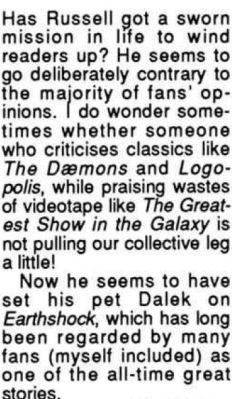
Recently I’ve been digging through my piles of DWW and DWM. 40+ years of collecting the magazine means that a chronological re-read would be a little impractical (although it would make a good blog project for someone). Instead I’ve decided to use the randomizer (a useful device, even if it lacks true discrimination) to select some issues for me to peruse. First landing spot is issue 193 (November 1992) with Gary Russell in the editors seat.
Top news in the Gallifrey Guardian was the fact that Who would be running six days a week on UK Gold. Hurrah! Difficult to imagine now, but in those far off days access to the series was pretty limited unless you had access to the pirate video network. And even if you did, you may very well have been struggling to make out blobs in a snowstorm (some of those nth generation dubs were very hard on the eyes).

Marcus Hearn interviewed Roy Castle about his career and specifically his role as big-screen Ian. Castle always came across as a lovely chap and this interview does nothing to dispel this view. He had fond memories of Peter Cushing (another person you never hear a bad word about).

Controversy Corner tackled the thorny topic of canon. Shudder. That’s a kettle of worms you never really want to open.

The Android Invasion received a typically thorough archive feature from Andrew Pixley whilst the comic strip featured part one of Pureblood. Slightly squidgy looking Sontarans were the baddies whilst there were a fair few swearwords (well, “cruck”) thrown about – possibly in homage to the New Adventures. After all, this was still at the point when the various spin offs (comics, books) were attempting to live in harmony – hence Benny accompanying the Doctor on his travels.

There’s an interesting interview with Brian Hodgson which covers all the bases you’d expect (such as how a piano and a key were integral to creating the TARDIS sound).

The postbag was still mildly fuming at Gary Russell’s review of Earthshock in DWM 191. Although if you really want to read a thorough demolition of the story then you’d be advised to check out Martin Wiggins’ piece in the relevant issue of In Vision.

And that’s about that for this issue, apart from a back-page plug for issue one of Classic Comics. Which are also probably worth digging out for a re-read ….








